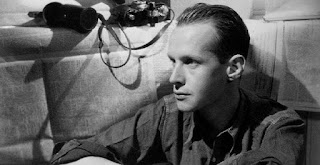I like how in this image, the centre of the face is over powered by negative space that also makes up the background. Therefore we can only see the highlighted outline and hair line of the subject. I think this has a very strong sense of mystery as we can't see any of the facial features so we don't actually know what the subject looks like. I think this is also quite abstract as facial features are usually a very important factor in portraiture as they define the person but this picture goes against that so it is not a typical portrait.
I really like this image, epecially how the subject is looking directly to the side and that outline of her face is very clear and distinct because of the fact that it is very highlighted and it's against the negative space. I also like the back of the head fades into negative space and we can't see the rest of their head, body or hair. This gives an illusion that she is 'floating' as it appears like she is only a face. This has a mysterious connotation.
I think this picture emphasizes the idea that low key lighting has a connotation of mystery. This is because of the way half the face is negative space so we only see the right half. Also I like the way the subject is looking straight into the camera lens so when looking at the picture it seems like he is looking at us. This adds to the mystery as he has a very serious facial expression.

This picture is a bit different as some of the body is highlighted as well as the face. I like how the light has been manipulated so only certain parts of the subject are seen and the rest is negative space. This has quite an abstract look as we can only see the face and arm. I also like the angle that this was taken at, it seems from quite low down and I like the way the subject is then looking down at the lens. I think this has a connotation of power because it appears like she is above everyone else.
I like how in this picture, the contours of the face and body have been very defined by the contrast in highlights and shadows. When researching and shooting for form I found that this was an important factor that helped contribute to the emphasis of the form of the subject. Also I like the way the hair at the top shows that the light is coming from above her.














































